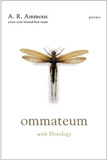December 25, 2010Ommateum (with Doxology) by A.R. Ammons
Review by Troy Jollimore 
OMMATEUM (WITH DOXOLOGY)
by A. R. Ammons
WW Norton & Company
500 Fifth Ave
New York, NY 10110
ISBN# 0-393-06446-8, 73 pp., $23.95
www.wwnorton.com
The world of Ommateum, a sequence of thirty numbered but not otherwise titled poems, reminds one of a Henri Rousseau painting, in which everything is a symbol of itself, and every object exists at the highest level of abstraction. “The wind,” “the sun,” “the moon,” and various other such meteorological and astronomical entities make multiple appearances. All display tendencies to act unpredictably or randomly, to engage in petty envy or experience grief, to make ironic or revealing comments about themselves–to behave, in short, much like human beings. Also humanized are such ‘characters’ as Death, who, “throwing her head about lifted / the skirts of her gown / and danced wildly,” and “the oatfields,” who, in the poet’s account, “looked around at the stubble and straw” and express their feelings about their situation with a conclusive, evocative, “Oh.”
“Oh” is also the most common utterance of the poem’s “I”–an utterance which is intended, perhaps, to say everything and nothing simultaneously. (As Ammons writes in his foreword, the poems “suggest and imply and rather grow in the reader’s mind than exhaust themselves in completed, external form.”) “I” is possibly the most abstract character of all, who seems for the most part to exist in utter alienation from history and biography (albeit showing up–don’t ask me how or why–in Antioch in 1098 and in Strasbourg in 1349). “I”‘s presence is almost perfectly reliable, and some of the poems manage to create a certain suspense by delaying its (his?) appearance. Halfway through the sequence, though, we reach 15, the only poem of the thirty in which “I” makes no explicit appearance at all–though it is possible, of course, that the third-person “he” is simply the “I” viewed from another perspective:
no one knew
that he had ever flown
he was no less
no more known
to stones he left a stone
(“15”)
As if to make up for this show of first-person restraint, the rather monomaniacal 24 is composed around a vertical line of obsessively repeating iterations of ‘I’:
Falling too through scopes of
variables
I
in the
I-beam is some
for the moment accidental mote
Behind the I
I discloses
flows
winds and seas
of particles
(“24”)
Ommateum was first published in 1955, privately printed by the poet. No one at the time, including Ammons himself, knew that he was to become a significant figure in American poetry, and the book must have baffled many of the few readers in whose hands it managed to end up. Now, looking back, we can’t help but interpret the book in the light not only of the large and impressive body of work Ammons would go on to accomplish but also of the tradition of radical experimentalism that runs through American poetry in the second half of the twentieth-century. Still, if it is too late for the poem to shock us, it seems to have retained its power to entice and puzzle; and one quite frequently catches, behind that elusive “I”, a glimpse of a richly endowed mind doing its best to relate, in an honest and authentic way, its encounters with the various and bewildering phenomena of our universe:
A crippled angel bent in a scythe of grief
mourned in an empty lot
Passing by I stopped
amused that immortality can grieve
and said
It must be exquisite
(“28”)